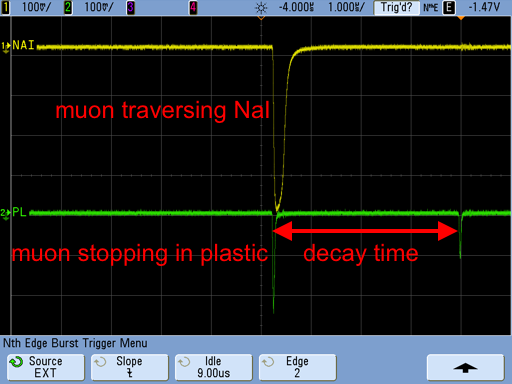Web measurement of muon decay
This page provides a way to determine the muon lifetime. The muon is an elementary
particle, one of the three leptons in the Standard Model. It does not decay very fast,
because the only decay mechanism occurs by the weak interaction.
There would not be any muons to detect if they were not continually produced. This
happens by the impact of cosmic rays on the atmosphere. The "rays" are mostly protons and
other nuclei with very high energies. At heights of over ten kilometers this gives rise to
muons that travel to the earths surface with very high kinetic energies, almost at the
speed of light (300 meter per microsecond). These muons penetrate the atmosphere and also
buildings.
Still, the muons are charged particles and they loose energy by ionisation along their
trail. Somewhere they must come to a stop. Sometimes this happens inside our detector and
this one can see on our web-enabled
oscilloscope.
 The horizontal scale is one microsecond per division. The green trace shows the signal of
a photomultiplier tube coupled to a piece of plastic scintillator. The oscilloscope is set
to trigger on this signal when a second event occurs within 9 µs of a preceding
event. The offset makes that the second peak is displayed 4 µs to the right of the
center. Almost always this is a peak that is caused by muon decay (detected by the
ionization trail of the resulting electron or positron).
The horizontal scale is one microsecond per division. The green trace shows the signal of
a photomultiplier tube coupled to a piece of plastic scintillator. The oscilloscope is set
to trigger on this signal when a second event occurs within 9 µs of a preceding
event. The offset makes that the second peak is displayed 4 µs to the right of the
center. Almost always this is a peak that is caused by muon decay (detected by the
ionization trail of the resulting electron or positron).
The preceding green peak is due to the ionization trail of the muon when it enters
the plastic. The time difference is the decay time. Decay is a random process. It will
take several events before one can make an estimate of the muon lifetime. Decays inside
the block scintillation material are rare: an hour can go without events, so be patient.
The yellow trace of the oscilloscope shows the signal from a detector located above
the detector in which the decay is measured. Often the muon that is detected in the
plastic will have traversed this detector on its way from the upper atmosphere. It is
wider because sodium iodide i a slower scintillator material than the plastic detector.
When the muon path is not vertical this peak will be absent. Sometimes the NaI detector
may show other peaks.
Assignment
- Estimate the muon lifetime using a sufficient number of images from the
web-enabled oscilloscope.
Make a histogram. Also determine median and average values. Estimate statistical
errors in your result.
- Make measurements of the
muon rate to estimate
the chance that the two peaks in the green trace are due to different muons
traversing the plastic scintillator.
- What other systematic errors influence your result?
- How is it possible that muons produced in the upper atmosphere can reach us within
their lifetime?
- Present images of any strange events. Try to give an explanation.
Reading:
- Literature values can be found on Particle Data Group
- A. Melissinos, Experiments in Modern Physics, 2nd ed. (2003)
 The horizontal scale is one microsecond per division. The green trace shows the signal of
a photomultiplier tube coupled to a piece of plastic scintillator. The oscilloscope is set
to trigger on this signal when a second event occurs within 9 µs of a preceding
event. The offset makes that the second peak is displayed 4 µs to the right of the
center. Almost always this is a peak that is caused by muon decay (detected by the
ionization trail of the resulting electron or positron).
The horizontal scale is one microsecond per division. The green trace shows the signal of
a photomultiplier tube coupled to a piece of plastic scintillator. The oscilloscope is set
to trigger on this signal when a second event occurs within 9 µs of a preceding
event. The offset makes that the second peak is displayed 4 µs to the right of the
center. Almost always this is a peak that is caused by muon decay (detected by the
ionization trail of the resulting electron or positron).